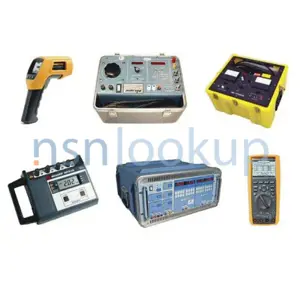Signal Generator
Item Name Code (INC) 03901
 |
An instrument which produces a continuous audio and/or radio frequency voltage, and which is designed for test purposes only. It may provide an output at one or more fixed frequencies or be continuously variable over one or more bands. The fixed frequency type is distinguished from CALIBRATOR, FREQUENCY in that it is a voltage source and is not primarily intended for checking frequencies from other sources. Excludes GENERATOR, INTERFERENCE.
 Additional Information for Signal Generator
Additional Information for Signal Generator
Signal generators are devices used in electrical and electronic testing and measurement to generate various types of electrical signals. They are commonly used in laboratories, research facilities, and manufacturing industries.
Signal generators are part of the supply class "Electrical And Electronic Properties Measuring And Testing Instruments" in the supply group "Instruments And Laboratory Equipment." This class includes a wide range of instruments used to measure and test electrical and electronic properties, such as voltage, current, resistance, capacitance, frequency, and more.
Signal generators are specifically designed to generate electrical signals of different waveforms, frequencies, amplitudes, and modulation types. They are used for various purposes, including:
1. Testing and troubleshooting electronic circuits: Signal generators can be used to simulate different types of signals that electronic circuits may encounter in real-world scenarios. This helps in testing the performance, functionality, and reliability of the circuits.
2. Calibration of instruments: Signal generators are used to calibrate other measuring instruments, such as oscilloscopes, spectrum analyzers, and frequency counters. By providing known and accurate signals, signal generators ensure the accuracy and reliability of these instruments.
3. Research and development: Signal generators are essential tools in research and development activities related to electronics, telecommunications, and signal processing. They are used to generate signals for testing new technologies, developing new products, and conducting experiments.
4. Education and training: Signal generators are widely used in educational institutions and training centers to teach students about signal generation, modulation techniques, and various types of waveforms. They help students understand the principles of electronics and telecommunications.
Signal generators can generate different types of signals, including:
1. Continuous wave (CW) signals: These are simple, continuous signals with a constant frequency and amplitude. They are commonly used for basic testing and calibration purposes.
2. Function generator signals: These signals can generate various waveforms, such as sine, square, triangle, sawtooth, and pulse waves. They are used for testing and simulating different types of signals encountered in electronic circuits.
3. Arbitrary waveform generator (AWG) signals: AWG signals are more complex and can generate custom waveforms based on user-defined mathematical equations or imported data. They are used for advanced testing and research purposes.
4. Modulated signals: Signal generators can also generate modulated signals, where the amplitude, frequency, or phase of the signal is varied according to a modulation scheme. This is used in telecommunications, radio frequency (RF) testing, and signal processing applications.
Overall, signal generators are versatile instruments that play a crucial role in electrical and electronic testing and measurement. They provide engineers, researchers, and technicians with the ability to generate and manipulate signals for a wide range of applications.